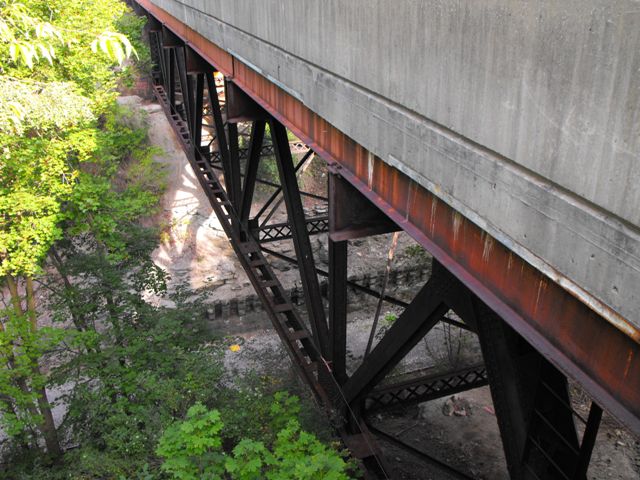We Recommend:
Bach Steel - Experts at historic truss bridge restoration.
Culmerville Bridge

Primary Photographer(s): Nathan Holth
Bridge Documented: August 1, 2010
Culmerville Road: Allegheny County, Pennsylvania: United States
1921 By Builder/Contractor: American Bridge Company of New York, New York and Engineer/Design: Bessemer and Lake Erie Railroad
1991
135.0 Feet (41.1 Meters)
141.0 Feet (43 Meters)
26.6 Feet (8.11 Meters)
1 Main Span(s)
2102801300705

View Information About HSR Ratings
Bridge Documentation
This bridge no longer exists!
Bridge Status: Demolished and replaced.View Archived National Bridge Inventory Report - Has Additional Details and Evaluation

This bridge is a traditionally composed truss bridge, but is an uncommon example of a short-span deck truss bridge. Although it has been altered by widening on one side and some replacement and repair of members, the overall truss superstructure retains original materials and design. The original pole railings as outlined on the 1921 plans for the bridge remain on the bridge on the side that was not widened, while the other side of the bridge has lost railings with modern New Jersey barriers in place. The Historic Bridge Inventory considers the bridge historic because of association with a historic railroad line, the Bessemer and Lake Erie Railroad. The bridge crosses that railroad's line, but also was designed by the railroad as well, according to the Historic Bridge Inventory. The original plans for the bridge also list the American Bridge Company's Pittsburgh location, showing the company was also involved with the bridge construction, perhaps fabrication and possibly erection as as well. The plans for the bridge show a reinforced concrete deck with concrete encased deck stringers. The stringer encasement and the deck slab were an integral casting. The plans also show the original deck layout, consisting a a roadway and sidewalks on each side of the bridge. Both the outermost portions of the roadway and the sidewalks are cantilevered beyond the truss lines. The bridge is built on a 2% grade up eastward. Perhaps the most interesting thing found in the original plans is a drawing shown at right which shows that the bridge was preceded by a tunnel. According to the drawing, the tunnel only served a single track. It would appear that this bridge was built because of a project to convert the railroad line into a two track line. The railroad apparently decided it was easier to daylight the tunnel and create a wider cut with a bridge rather than construct a second or wider tunnel.
Regardless of this bridge's historic significance, demolition and replacement is planned for this historic bridge. Although it is not evident that Section 106 has been conducted yet, PennDOT already defined a proposed project scope in June 2010 of replacing the historic truss superstructure and potentially reusing the substructure. This is odd, because normally when a project that involves a historic structure is begun a more neutral "project need" is defined which usually outlines the need to improve the crossing, but not does specify what means will be used to make that improvement. This is critical because a non-neutral statement would imply a bias in favor of a particular project alternative before the feasibility of each alternative has been considered alongside public and consulting party involvement. Statements were also made by PennDOT during June 2010 that suggested they felt the bridge superstructure could be replaced without an adverse effect. Because the truss superstructure is the historic structure in question, being associated with and designed by a historic railroad, removal of the truss should indeed be an adverse effect and would require Section 106.
Information and Findings From Pennsylvania's Historic Bridge InventoryDiscussion of Bridge 'The 1921, single span, 141' long, riveted, Warren with verticals deck truss bridge is supported on concrete abutments. Most of the members of the traditionally composed trusses are built up. In 1991 the bridge was rehabilitated. A cantilevered deck section was added as was the safety shape barrier. The trusses were also strengthened by the bolted connection of additional members. The bridge is late and altered example of a common bridge type/design. It is not individually technologically significant, but it is historically significant in association with the Bessemer & Lake Erie RR, one of the most important short lines in the region. The railroad built the bridge during its period of significance. Discussion of Surrounding Area The bridge carries a 2 lane street and 1 sidewalk over 2 tracks of the B&LE RR located in a cut. The B&LE was founded in the early 20th century by US Steel as a means to transport steel and coal between USS's Mon Valley operations and the shipping facilities on Lake Erie. Bridge Considered Historic By Survey: Yes |
![]()
Photo Galleries and Videos: Culmerville Bridge
Bridge Photo-Documentation
Original / Full Size PhotosA collection of overview and detail photos. This gallery offers photos in the highest available resolution and file size in a touch-friendly popup viewer.
Alternatively, Browse Without Using Viewer
![]()
Bridge Photo-Documentation
Mobile Optimized PhotosA collection of overview and detail photos. This gallery features data-friendly, fast-loading photos in a touch-friendly popup viewer.
Alternatively, Browse Without Using Viewer
![]()
Maps and Links: Culmerville Bridge
This historic bridge has been demolished. This map is shown for reference purposes only.
Coordinates (Latitude, Longitude):
Search For Additional Bridge Listings:
Bridgehunter.com: View listed bridges within 0.5 miles (0.8 kilometers) of this bridge.
Bridgehunter.com: View listed bridges within 10 miles (16 kilometers) of this bridge.
Additional Maps:
Google Streetview (If Available)
GeoHack (Additional Links and Coordinates)
Apple Maps (Via DuckDuckGo Search)
Apple Maps (Apple devices only)
Android: Open Location In Your Map or GPS App
Flickr Gallery (Find Nearby Photos)
Wikimedia Commons (Find Nearby Photos)
Directions Via Sygic For Android
Directions Via Sygic For iOS and Android Dolphin Browser
USGS National Map (United States Only)
Historical USGS Topo Maps (United States Only)
Historic Aerials (United States Only)
CalTopo Maps (United States Only)






